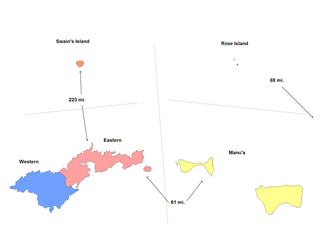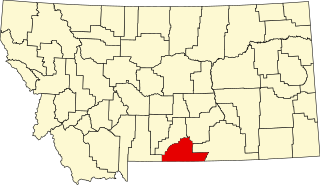Related Research Articles

This is a list of the buildings, sites, districts, and objects listed on the National Register of Historic Places in American Samoa. There are currently 31 listed sites spread across the three districts of American Samoa. There are no sites listed on the unorganized atoll of Swains Island.

Millstone Bluff is a natural bluff in Pope County, Illinois, United States, located near the community of Glendale. Listed on the National Register of Historic Places because of its archaeological significance, Millstone Bluff is one of three National Register sites in Pope County, along with the Golconda Historic District and part of the Kincaid Mounds State Historic Site.
Mero Mound Group or Diamond Bluff Site is an archeological site near Diamond Bluff, Wisconsin, in Pierce County, Wisconsin. It consists of at least two village sites surrounded by hundreds of mounds, including three effigy mounds. All were constructed from around 1000 AD to 1300 AD.

This is a list of the National Register of Historic Places listings in Lafourche Parish, Louisiana.

This is a list of the National Register of Historic Places listings in Carbon County, Montana.
Palo Hincado Site, also known as BA-1, is an archeological site in or near Barranquitas, Puerto Rico. The site includes a plaza, a 33 metres (108 ft) by 15 metres (49 ft) ball court, and petroglyphs. Reportedly a number of petroglyphs on stones around the plaza and ball court) have been removed by collectors.
Cueva de Los Indios, also known as the Cueva Punta Maldonado site, in the municipality of Loíza, Puerto Rico, was listed on the National Register of Historic Places in 1982.
Quebrada Maracuto, in the municipality of Carolina, Puerto Rico, is a prehistoric rock art site. It was listed on the National Register of Historic Places in 2004.

Cueva Lucero is a cave and archeological site in the Guayabal barrio of the Juana Díaz municipality, in Puerto Rico. The cave includes more than 100 petroglyphs and pictographs "making it one of the best examples of aboriginal rock art in the Antilles." It has been known to archeologists since at least the early 1900s. Most of its images are zoomorphic. The site is known to locals including rock-climbers and spelunkers and there is some modern graffiti.

This portion of National Register of Historic Places listings in Puerto Rico is along the central mountain region, from Las Marías and Maricao in the central-west to Juncos in the central-east, including the slopes of the Cordillera.

The Reef Bay Trail petroglyphs are a group of Taíno petroglyph carvings found in the Virgin Islands National Park on the island of St. John, United States Virgin Islands. They are located in a part of the park called the Reef Bay Trail.

The Bellows Falls Petroglyph Site is an archaeological site containing panels of precontact Native American petroglyphs in Bellows Falls, Vermont. Located near the Vilas Bridge on bedrock west of and above the Connecticut River, adjacent to Great Falls, they depict a rarely-seen assemblage of anthropomorphic figures that is believed to be unique in New England, and uncommon even in surrounding geographic areas. The site was listed on the National Register of Historic Places in 1990.

The Abert Lake Petroglyphs are a prehistoric archaeological site in Lake County, Oregon, United States. Peoples of the Great Basin cultural tradition pecked the images onto two basaltic boulders near major game migration routes. They are believed to be connected with rituals related to hunting activities, and contribute to the larger understanding of subsistence patterns in the northern Great Basin. They were made within the last 10,000 years, but their age cannot be stated more precisely due to the difficulty of dating petroglyphs.
The Edgemont Shelter, also designated by the Smithsonian trinomial 3VB6, is a prehistoric rock art site in Van Buren County, Arkansas. Located on a bluff overlooking Greers Ferry Lake, it consists of a panel extensively painted with petroglyphs. The site has been dated to about 1500.

The Tolar Petroglyph Site is an archeological site in Sweetwater County, Wyoming. The site includes a sandstone rock formation with 32 panels of petroglyphs running for 150 feet (46 m) along the rock face. Many of the illustrations are of horse-mounted people of the Plains Indians in historical times. Other motifs include the turtle motif, spirit bear and shield-carrying warriors.
The Rosenstock Village site is a historic site located in Frederick County, Maryland, United States, near the city of Frederick. It contains the remains of a Late Woodland Village situated on a bluff overlooking the Monocacy River. The village was occupied between A.D. 1335 and A.D. 1400, based on artifact analysis and radiocarbon dating. It is similar to the Montgomery Complex, which is a cultural complex made up of Late Woodland sites located on the Potomac River. The site was excavated in 1979 and from 1990 to 1992, and estimates suggest that 93% of the site remains undisturbed. They uncovered a large oval area surrounded by pits, a large sheet midden area, and what are believed to be two sweatlodges. The excavations have yielded a trove of artifacts and animal remains. The site was listed on the National Register of Historic Places in 2018.
Wickiup Hill is a Native American archeological region near Toddville, in Linn County, Iowa. The area has the Wickiup Hill Outdoor Learning Center which was built where a Meskwaki village once stood. Wickiup Hill has been excavated by archeologists.
Cueva La Mora is the name of a cave and archaeological site located in or near Comerío, Puerto Rico. The cave was added to the United States National Register of Historic Places on March 10, 1983, due to its importance in yielding information about the Pre-Columbian history of Puerto Rico and the Caribbean.
References
- ↑ Federal and state laws and practices restrict general public access to information regarding the specific location of this resource. In some cases, this is to protect archeological sites from vandalism, while in other cases it is restricted at the request of the owner. See: Knoerl, John; Miller, Diane; Shrimpton, Rebecca H. (1990), Guidelines for Restricting Information about Historic and Prehistoric Resources, National Register Bulletin, National Park Service, U.S. Department of the Interior, OCLC 20706997 .
- ↑ "La Barge Bluffs Petroglyphs".
- ↑ Bureau of Land Management (May 5, 2014). "La Barge Bluffs Petroglyph Site listed in the National Register of Historic Places".